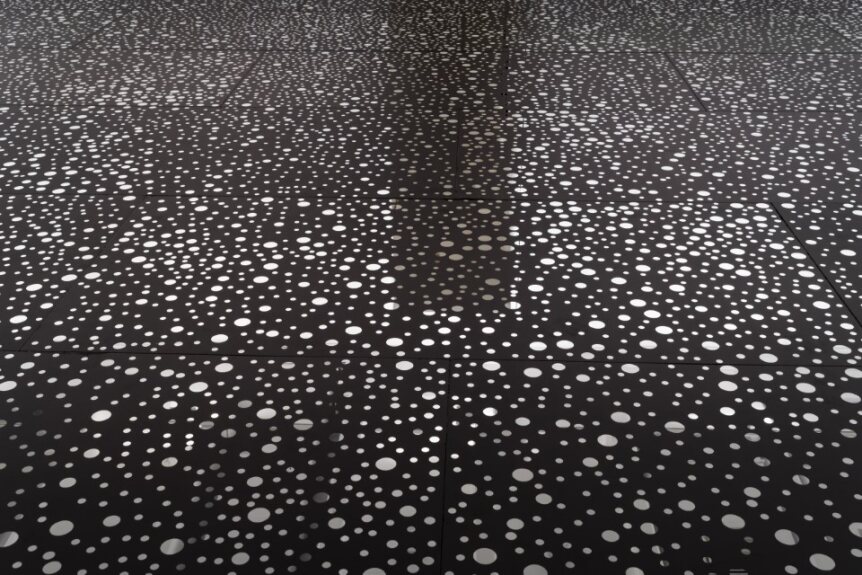A Kudjla/Gangalu man from North Queensland with South Sea heritage, Daniel Boyd (re)interprets through his multidisciplinary practice intersectional narratives of colonial expansion and imperial conquest, Indigenous and Torres Strait Islander mistreatment and, broadly, cultural and economic exploitation of Australia.
Rainbow Serpent (Version) is Boyd’s first major showcase in Meanjin/Brisbane to which he bears a profound connection through his matrilineal Yuggera heritage.
The first room features large, restrained, chromatic canvases, which set an unworldly, almost mystical atmosphere. The image of an Indigenous man holding an axe above the head of a bare-breasted woman occupies the narrower, furthest wall. It is accidentally reflected and expanded by the austere polished concrete floorings. Yet, this duplication doesn’t preserve the clumsiness of his gesture, or the gentle gaze affixed beyond the camera as if to seek approval.
On another wall, there’s a portrait of an Elder awkwardly holding a boomerang. Next to it, is the tight headshot crop of a bewildered child. Across time, a young Daniel Boyd watches him from the protective arms of his beautiful mother.
With this last exception, the portraits are reworked archival prints of staged photographs of First Nations people, greedily captured with ethnocentric curiosity. In Boyd’s now-signature style, multiple layers of oil, watercolour, clear pH neutral glue, pastel or charcoal conceal or reveal fragments of the imagery. Of various dimensions, the convex archival glue dots are partially overpainted as well. Half-erased textures or shimmering dashes add to the tensions of opacity and transparency.
It is the work of Martinique writer, poet, philosopher and literary critic Édouard Glissant that informs Boyd’s artistic methods. In his 1990 book, Poétique de la relation (Poetics of Relation), Glissant argues for ‘the right to opacity’ of Indigenous cultures. Not unmasking and examining difference, but accepting its inscrutable character, sustains the preservation and conservation of Indigenous cultures and knowledge systems. ‘The right to opacity […] would be the real foundation of Relation, in freedoms,’ writes Glissant.
Both aesthetic and ethical forms of resistance against Eurocentric domination, Boyd’s protruding dots disrupt and unsettle the established anthropological ways of seeing. They interrogate Australia’s colonialist past, crimes of atrocity, Aboriginal survival, lived experiences and personal memories. Their spectral play of light and shade creates a sense of fluidity and transcendental space, unrestrained surface and depth.
In the primary gallery space, Untitled (2023) consists of hundreds of circular mirrored discs of various sizes, irregularly mounted on dark floor tiles. Attempting to find and follow a path through the reflective dots, visitors will find the sinuous lines are often interrupted in an act of constant refiguration. Untitled is the beating heart of Boyd’s exhibition, its unbounded source of raking lights and glistening dots or ‘lenses’ in artists’ terms. With each of them, new entry points to interpret and fathom the artworks draw in the viewer.
For another section, Boyd brings around a charred dining table renderings of breadfruit, an Indigenous fast-growing and inexpensive crop that would feed Caribbean slaves working on British plantations. Two other images are interposed – the Victorian-era studio portrait of a First Nations servant wearing a crisp white uniform with frills and a little mop cap, and the more recent photograph of the artist’s grandmother, part of the Stolen Generation and a domestic servant herself.
Their cross-generational dialogue reminds us that Australia’s colonial history of genocide, brutality, violence, slavery and forced labour is perpetuated in the present by unrelenting prejudice and inequity towards Indigenous people. Through the table’s round shaped punctures, light softly falls on the ground, in a voiceless witnessing.
Read: Performance review: New Reality, Immigration Museum
Shuffling time, Rainbow Serpent (Version) creates an alternative architecture of continuous open connections.
Rainbow Serpent (Version) is curated by Liz Nowell and will be exhibited at the Institute of Modern Art in Brisbane until 16 December 2023





